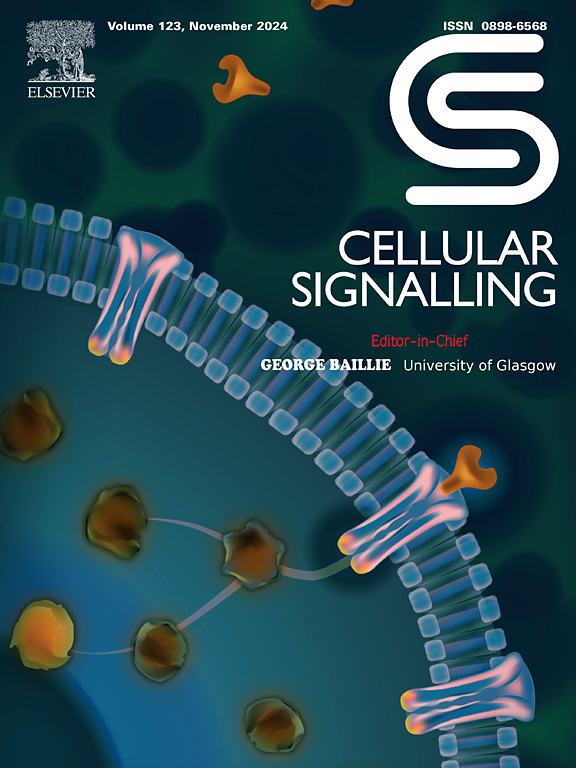ARL8B 与 RAB2A 相互作用,通过 MAPK/ERK 信号转导促进肝细胞癌的进展并抑制来伐替尼的抗肿瘤活性。
IF 4.4
2区 生物学
Q2 CELL BIOLOGY
引用次数: 0
摘要
肿瘤复发和转移是影响肝细胞癌(HCC)患者术后生存的重要因素。ADP 核糖基化因子样 GTPase 8B(ARL8B)在溶酶体功能、免疫反应和细胞通讯等许多生物过程中发挥着至关重要的作用,所有这些过程都与肿瘤的发生和发展有关。然而,它在 HCC 中的作用仍不清楚。在本文中,我们发现与正常肝组织相比,ARL8B 在 HCC 组织中持续升高,这表明 HCC 患者的预后不利。ARL8B 水平的升高促进了 HCC 在体外和体内的恶性表型。值得注意的是,ARL8B 还能诱导 HCC 细胞的上皮细胞向间质转化(EMT)。从机理上讲,生物信息学分析结合质谱分析的结果揭示了ARL8B的潜在下游靶分子RAB2A。ARL8B直接与RAB2A相互作用,增加了GTP结合的RAB2A的水平,从而促进了细胞外信号调节激酶(ERK)信号通路的激活。有趣的是,在Hep3B细胞中敲除ARL8B能增强来伐替尼在体外和体内的抗肿瘤活性。此外,AAV-shARL8B通过来伐替尼增强了对HCC生长的抑制作用,这为来伐替尼不敏感患者了解其作用机制提供了新的视角。总之,ARL8B通过RAB2A介导的MAPK/ERK信号通路激活促进了HCC的恶性表型和EMT,有望成为HCC患者有价值的预后指标和治疗靶点。本文章由计算机程序翻译,如有差异,请以英文原文为准。
ARL8B promotes hepatocellular carcinoma progression and inhibits antitumor activity of lenvatinib via MAPK/ERK signaling by interacting with RAB2A
Tumor recurrence and metastasis are important factors affecting postoperative survival in hepatocellular carcinoma (HCC) patients. ADP Ribosylation factor-like GTPase 8B (ARL8B) plays a crucial role in many biological processes, including lysosomal function, immune response, and cellular communication, all of which are related to the occurrence and development of tumors. However, its role in HCC remains unclear. Herein, we revealed that ARL8B is consistently elevated in HCC tissues compared to normal liver tissues, suggesting an unfavorable outcome in HCC patients. Increased ARL8B levels promoted the malignant phenotype of HCC in vitro and in vivo. Notably, ARL8B also induced epithelial-to-mesenchymal transition (EMT) in HCC cells. Mechanistically, the results of bioinformatics analysis combined with mass spectrometry revealed the potential downstream target molecule RAB2A of ARL8B. ARL8B directly interacted with RAB2A and increased the levels of GTP-bound RAB2A, thereby contributing to the activation of the extracellular signal-regulated kinase (ERK) signaling pathway. Interestingly, knockout of ARL8B in Hep3B cells enhanced the antitumor activity of lenvatinib in vitro and in vivo. Furthermore, AAV-shARL8B enhanced the inhibition of HCC growth through lenvatinib, providing new insights into its mechanism of action in lenvatinib-insensitive patients. In conclusion, ARL8B promotes the malignant phenotype of HCC and EMT via RAB2A mediated activation of the MAPK/ERK signaling pathway and is expected to be a valuable prognostic indicator and therapeutic target for HCC patients.
求助全文
通过发布文献求助,成功后即可免费获取论文全文。
去求助
来源期刊

Cellular signalling
生物-细胞生物学
CiteScore
8.40
自引率
0.00%
发文量
250
审稿时长
27 days
期刊介绍:
Cellular Signalling publishes original research describing fundamental and clinical findings on the mechanisms, actions and structural components of cellular signalling systems in vitro and in vivo.
Cellular Signalling aims at full length research papers defining signalling systems ranging from microorganisms to cells, tissues and higher organisms.
 求助内容:
求助内容: 应助结果提醒方式:
应助结果提醒方式:


